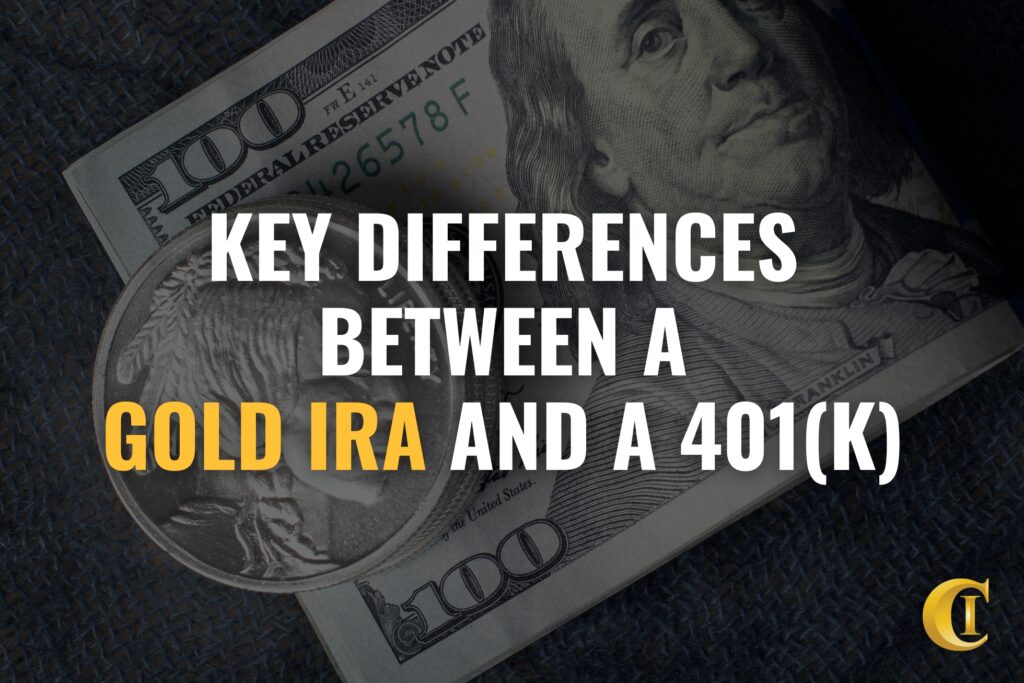Gold IRA vs 401(k): Key Differences
The article compares gold IRAs and 401(k)s as retirement savings options. It details their key differences, benefits, and drawbacks to help investors decide which aligns with their financial goals.

Written by Rick Erhart
Rick Erhart is an experienced precious metals professional with more than ten years in the field. He earned a degree in finance and is widely regarded as a specialist in self-directed IRAs.
Every American worker dreams of retiring someday, envisioning a life of freedom. When saving for that future, you’ll likely choose between a 401(k) and an IRA, as these are the most popular retirement options. Both have their own benefits and drawbacks, and you can even combine them if it suits your needs.
If you already have retirement savings in your 401(k) and want to protect or grow them, it might be wise to invest in gold by transferring an old 401(k) into a gold IRA.
Both gold IRAs and 401(k) plans offer clear benefits for investors planning for retirement. However, their distinct features mean one may align better with your financial goals.
Brief Overview
A gold IRA appeals to investors seeking to diversify their retirement savings with physical gold or silver. This account serves as a safe haven against market fluctuations, though it can come with higher fees and more complex management requirements.
A 401(k) is offered through employers and provides a straightforward way to save for retirement. It offers tax benefits and often includes employer matching contributions, with funds typically invested in various conventional assets.

Continue reading to understand the differences between gold IRAs and 401(k)s and determine which option best fits your needs.
Comparison of Gold IRAs and 401(k)s
| Aspect | Gold IRA | 401(k) |
|---|---|---|
| Definition | A self-directed retirement account for investing in IRS-approved physical precious metals (gold, silver, platinum, palladium). | An employer-sponsored retirement plan for saving pre- or after-tax income. |
| Investment Choices | IRS-approved precious metals, full control over investment decisions for diversification. | Stocks, bonds, mutual funds. Limited to employer-selected options. |
| How to Start | Open an account with a precious metals custodian and trusted dealer. It requires careful planning. | Enroll through employer, typically during onboarding. |
| Contribution Limits | $7,000/year ($8,000 for age 50+ with $1,000 catch-up). | $23,500/year ($31,000 for age 50+ with $7,500 catch-up). |
| Loan Provisions | No loans. Early withdrawals before 59½ incur penalties. | Loans often allowed (up to 50% vested balance or $50,000). |
| Tax Benefits | In a traditional gold IRA, growth is tax-deferred, so you pay taxes only when you withdraw funds in retirement. Roth gold IRAs may offer tax-free withdrawals if specific conditions are met. | Contributions are usually pre-tax, reducing your taxable income now. Withdrawals in retirement are taxed as regular income. Roth 401(k)s allow after-tax contributions and tax-free withdrawals. |
| Advantages | Diversifies portfolio with stable assets. Potential hedge against inflation. Physical ownership. | Lowers taxable income. Employer matching. Liquid investments. |
| Drawbacks | Annual fees (around $250 yearly for storage and maintenance). Converting metals to cash may take time. Gold prices may fluctuate and might not always keep up with inflation. | Annual fees (vary by plan size and structure, usually around 0.3-1.2% of assets). Limited investment choices. Early withdrawals before 59½ incur 10% penalty plus taxes. |
| Minimum Investment | Often requires a sizable minimum investment (usually between $5,000 and $50,000). | Varies by employer. Some plans allow small paycheck contributions. |
Note: Contribution limits change yearly, check IRS.gov for updates.
Advantages of a Gold IRA Over 401(K)
Greater Flexibility in Tax Planning
A gold IRA empowers you to decide how your investments are taxed. You can opt to lower your taxable income now or allow your assets to grow without tax obligations until withdrawal. For more information, refer to our guide on gold IRA tax rules and regulations.
Better Investment Control
Gold IRAs allow investors to take charge of their portfolios, offering the freedom to select assets like gold, silver, platinum, or palladium. 401(k) plans, on the other hand, are managed by employers, and typically restrict investment choices to pre-selected mutual funds, stocks, and bonds.
Rollover Flexibility Without Penalties
You can transfer money from a 401(k) to a gold IRA without facing tax penalties by using a direct rollover. There’s no limit on the amount you can move, which gives investors the freedom to spread out their retirement savings while keeping the tax-deferred benefits. This option works well if you’re leaving an employer or looking to explore different investment choices.
Exemption from Required Minimum Distributions (RMDs) for Roth Gold IRAs
As of 2025, Roth gold IRAs are exempt from RMDs during the account holder’s lifetime, allowing investments to grow indefinitely. However, traditional gold IRAs require RMDs starting at age 73, similar to traditional 401(k)s.
Protection From Inflation and Currency Devaluation
Gold and other precious metals are widely viewed as stable assets. Their value tends to remain steady, avoiding sharp declines. Unlike 401(k) assets, which are denominated in fiat currency, gold’s intrinsic value can safeguard purchasing power over time. Including it in your portfolio can reduce risk and provide a buffer against inflation, enhancing overall financial security.
Downsides of a Gold IRA Compared to a 401(k)
Limited Protection From Creditors
Under the Employee Retirement Income Security Act of 1974 (ERISA), certain retirement accounts, like 401(k)s, are shielded from creditors. Gold IRAs, however, typically lack this protection, leaving your assets potentially vulnerable in cases of bankruptcy or lawsuits and can be seized to pay debts.
No Loan Options Available
While some 401(k) plans permit borrowing against your savings, gold IRAs do not offer this feature. To access funds, you must sell your precious metals, which may involve additional time and costs.
No Income Generation
Unlike stocks or bonds held in a 401(k), gold IRA does not produce dividends or interest. This can potentially limit the long-term growth of your portfolio compared to 401(k) investments.
Benefits of a 401(k) Over a Gold IRA
Higher Contribution Limits
A 401(k) allows you to contribute significantly more each year compared to a gold IRA, with annual limits over three times higher. Even if you don’t contribute the maximum, this flexibility means your investments have greater potential to grow over time.
Employer Matching Contributions
Many employers offer to match your 401(k) contributions, often up to a specific amount. These matches act as additional savings that don’t count toward your annual contribution limit, effectively boosting your retirement funds at no extra cost to you.
Immediate Tax Savings
Contributions to a 401(k) are taken from your pre-tax income, lowering your taxable earnings for the year. This reduction can increase your take-home pay and may qualify you for other income-based tax benefits, such as credits or deductions.
Downsides of a 401(k) Compared to a Gold IRA
Higher Taxes on Withdrawals
Since 401(k) contributions are tax-deferred, you’ll owe taxes on distributions. If you retire in a higher tax bracket or if tax rates rise in the future, you might end up paying more in taxes than the savings you gained from your contributions.
Stricter Early Withdrawal Rules
Unlike gold IRAs, which allow penalty-free withdrawals for specific purposes like funding education or purchasing a first home, 401(k) plans offer fewer exceptions to the 10% early withdrawal penalty. This limits your ability to access funds before retirement without incurring extra costs.
Which Is Better for You: A Gold IRA or a 401(k)?
Choosing between a gold IRA and a 401(k) depends on your financial situation, investment goals, and priorities. In some cases, the decision is straightforward. For instance, if you’re set on investing in physical precious metals, a gold IRA is your only option.
But when your preferences are less defined, how do you decide?
- Gold IRA might be a better option than a 401(k) if you prefer lower-risk investments and seek tax-free withdrawals in retirement (e.g., with a Roth gold IRA).
- A 401(k) might be a better option than a Gold IRA if you want to avoid high account maintenance fees and minimum investment requirements and benefit from employer-matched contributions.
Why Choose a Gold IRA?
Precious metals like gold are often seen as safer bets compared to stocks or bonds. If you’re looking to diversify your portfolio with a stable, less volatile asset, a gold IRA could be a smart move.
Gold is a better investment than a traditional 401(k) during market swings and economic uncertainty. Over the past 54 years, gold outperformed the S&P 500 in 23 years (nearly half the time) with an average outperformance of 28.8%.
It thrived during weak market periods like the 1970s inflation, dot-com bust, and post-2008 crisis recovery, beating the S&P 500 in 8 of 9 negative S&P years with 19.4% average returns vs. -15.3% for the S&P.
In contrast, the S&P 500 outperformed in 31 years, averaging 20.5% better returns (dominating in the 1980s, 1990s, and 2010s-2020s). Gold’s strength during downturns underscores its value as a diversification tool and hedge in sideways or bearish markets, making a gold IRA an appealing investment option.

However, gold IRAs often require significant capital, with many gold IRA companies setting minimum investments between $5,000 to $50,000. If you have a smaller budget, you might want to explore precious metals-related funds or ETFs within a 401(k) as an alternative way to gain exposure to precious metals.
Why Choose a 401(k)?
A 401(k) offers immediate tax advantages by reducing your taxable income with each contribution. While it may not provide tax-free withdrawals in retirement like a Roth gold IRA, it’s a practical choice if you want to lower your tax bill today.
Additionally, if your employer offers matching contributions, you can significantly boost your savings without extra effort.
Ultimately, your decision hinges on your risk tolerance, available funds, and long-term financial plans. A gold IRA suits those prioritizing stability and tax flexibility, while a 401(k) is ideal for those seeking higher contribution limits, employer perks, or lower entry costs.
Should You Have Both a Gold IRA and a 401(k)?
Maintaining both a gold IRA and a 401(k) can be a smart approach to building a robust retirement plan, as these accounts complement each other with their unique features.
You can diversify your investments and maximize your financial flexibility by combining the two retirement plans. Here’s how having both could benefit you:
- Tax Advantages Now and Later: A 401(k) reduces your taxable income with pre-tax contributions, lowering your tax bill today. Meanwhile, a gold IRA, especially if structured as a Roth IRA, can offer tax-free withdrawals in retirement, providing long-term tax savings.
- Diverse Investment Options: A gold IRA allows you to hold physical precious metals, adding a stable, tangible asset to your portfolio. In contrast, a 401(k) typically focuses on securities like stocks and bonds. Together, they create a balanced mix that can hedge against market volatility and inflation.
- Higher Contribution Limits: By utilizing both accounts, you can significantly increase your annual savings. A 401(k) has much higher contribution caps than a gold IRA, allowing you to save more overall and accelerate your retirement growth.
You don’t need to open both accounts at the same time. Gold IRAs often require substantial initial investments that might not be immediately feasible. Starting with a 401(k), especially if your employer offers matching contributions, can be a practical first step while you save for a gold IRA later.
Ultimately, having both accounts can enhance your financial security by blending the stability of precious metals with the growth potential of traditional investments. However, consider your budget, risk tolerance, and retirement goals before committing to both.
How to Roll Over a 401(k) into a Gold IRA
If you’re searching for a new place to allocate your 401(k) savings and prefer an option less tied to stock market fluctuations or economic trends, transferring funds to a gold IRA might be a smart choice.
Converting a 401(k) to a gold IRA allows you to diversify your retirement portfolio with precious metals while avoiding tax penalties. Following IRS-compliant steps (such as using a direct rollover) ensures compliance with regulations and a smooth transition.
Here are the steps to complete a penalty-free gold IRA rollover:
- Select the Type of Gold IRA. Determine whether a traditional or Roth gold IRA suits your needs. A traditional gold IRA offers tax-deductible contributions, reducing your taxable income now. A Roth gold IRA provides tax-free withdrawals in retirement, ideal if you expect to be in a higher tax bracket later.
- Choose a Reputable Gold IRA Company. Select a trusted company to help you set up an account with a gold IRA custodian and ensure IRS compliance. For a reliable experience, consider working with one of the leading gold IRA companies approved by the IRS to handle precious metals accounts.
- Set Up a Self-Directed IRA. Open a self-directed IRA, which is required for investing in physical precious metals like gold, silver, or platinum. This account type gives you the flexibility to include non-traditional assets in your portfolio.
- Initiate a Direct Fund Transfer. Coordinate with your 401(k) plan administrator and your new custodian to transfer funds directly into the gold IRA. A direct rollover avoids taxes and penalties, ensuring your savings remain intact.
- Purchase IRS-Approved Precious Metals. Use the transferred funds to buy gold or other approved metals. Your custodian will facilitate the purchase, and the metals will be stored in a secure, IRS-approved depository to meet regulatory standards.
- Select a Storage Facility. IRS rules prohibit storing gold IRA metals at home. Work with your custodian to choose an IRS-approved depository to safely store your precious metals. Ensure the facility aligns with your security and accessibility needs.
Additional Considerations
If the cost of purchasing physical gold feels daunting, fractional ownership can be a cost-effective alternative. This allows you to invest in smaller portions of high-value assets, making gold more affordable without sacrificing diversification.
Be aware of associated costs. Gold IRAs typically involve fees such as account setup, storage, shipping, and administration. While 401(k) plans also have fees, they are often lower.
Compare these expenses against your financial goals to determine if a gold IRA aligns with your retirement strategy. If diversifying with precious metals is a priority, the long-term benefits may outweigh the fees.
Conclusion
Deciding between a gold IRA and a 401(k) comes down to your financial priorities and risk tolerance.
- A gold IRA offers stability and tax flexibility through precious metals, ideal for diversification and inflation protection.
- A 401(k) provides higher contribution limits, employer matches, and immediate tax savings, suiting those focused on growth and simplicity.
Combining both can balance risk and reward, leveraging their complementary strengths. Evaluate your budget, goals, and the costs involved to choose the path (or combination) that secures your retirement best.
